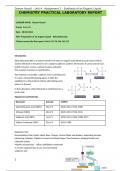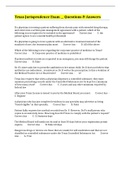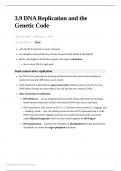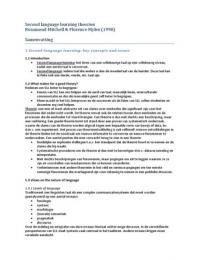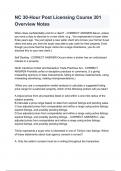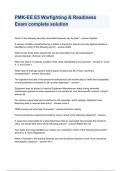Probability Concepts
Understanding Random Variables and Probability
Random variables are quantities that can take on different values
according to some random chance. There are two types of random
variables: discrete and continuous. Discrete random variables can only
take on specific, separate values, while continuous random variables can
take on any value within a certain range.
Probability is a measure of how likely an event is to occur. It is
represented as a number between 0 and 1, with 0 meaning the event will
never occur and 1 meaning the event will always occur. Probabilities can
be calculated using various rules and formulas, such as the addition rule
and the multiplication rule.
The addition rule states that the probability of either event A or event B
occurring is equal to the probability of event A occurring plus the
probability of event B occurring, minus the probability of both events A
and B occurring. This can be represented as:
P(A or B) = P(A) + P(B) - P(A and B)
The multiplication rule states that the probability of both event A and
event B occurring is equal to the probability of event A occurring
multiplied by the probability of event B occurring, given that event A has
occurred. This can be represented as:
P(A and B) = P(A) * P(B|A)
For example, suppose we have a bag with 5 red balls and 3 blue balls. If
we draw one ball at random, the probability of drawing a red ball is 5/8,
and the probability of drawing a blue ball is 3/8. The probability of
drawing either a red or a blue ball is:
P(red or blue) = P(red) + P(blue) - P(red and blue) = 5/8 + 3/8 - 0 = 1
This makes sense, because there are no other colors of balls in the bag.
The multiplication rule can also be used to calculate the probability of two
events occurring in sequence. For example, suppose we roll a fair six-
sided die twice. The probability of rolling a 3 on the first roll and a 4 on
the second roll is:
P(3 on first roll and 4 on second roll) = P(3 on first roll) * P(4 on second
roll|3 on first roll) = 1/6 * 1/6 = 1/36
, Probability distributions are used to describe the possible values and
probabilities of a random variable. The two main types of probability
distributions are probability mass functions (PMFs) and probability density
functions (PDFs). PMFs are used for discrete random variables, and PDFs
are used for continuous random variables.
For example, suppose we toss a fair coin three times. The possible number
of heads (H) and tails (T) that we can get are:
HHH (3 heads)
HHT
HTH
HTT
THH
THT
TTH
TTT (3 tails)
There are 8 possible outcomes, and each outcome is equally likely, with a
probability of 1/8. The PMF of the number of heads we can get is:
| Number of Heads (X) | 0 | 1 | 2 | 3 | |---|---|---|---|---| | PMF (P(X)) | 1/8 |
3/8 | 3/8 | 1/8 |
The mean (also called the expected value) of a random variable is a
measure of its central tendency. It is calculated as the sum of all possible
values, each multiplied by its probability. For a discrete random variable X
with possible values x1, x2, ..., xn and corresponding probabilities p1,
p2, ..., pn, the mean is:
Expected Value (E[X]) = x1 * p1 + x2 * p2 + ... + xn * pn
For example, suppose we have a six-sided die with the following PMF:
| Number (X) | 1 | 2 | 3 | 4 | 5 | 6 | |---|---|---|---|---|---|---| | PMF (P(X)) |
1/16 | 2/16 | 3/16 | 4/16 | 5/16 | 1/16 |
The mean is:
E[X] = (1 * 1/16) + (2 * 2/16) + (3 * 3/16) + (4 * 4/16) + (5 * 5/16) + (6 *
1/16) = 3.5
,The variance of a random variable is a measure of how much its values
vary from the mean. It is calculated as the sum of the squared difference
between each possible value and the mean, each multiplied by its
probability. For a discrete random variable X with possible values x1, x2, ...,
xn and corresponding probabilities p1, p2, ..., pn, the variance is:
Variance (Var[X]) = (x1 - E[X])^2 * p1 + (x2 - E[X])^2 * p2 + ... + (xn -
E[X])^2 * pn
For example, suppose we have a random variable X with the following
PMF:
| Number (X) | 1 | 2 | 3 | |---|---|---|---| | PMF (P(X)) | 0.3 | 0.4 | 0.3 |
The mean is:
E[X] = (1 * 0.3) + (2 * 0.4) + (3 * 0.3) = 2.1
The variance is:
Var[X] = (1 - 2.1)^2 * 0.3 + (2 - 2.1)^2 * 0.4 + (3 - 2.1)^2 * 0.3 = 0.45
The standard deviation is the square root of the variance and is a measure
of the amount of "spread" in the data. For example, if the standard
deviation of a set of data is small, it means that the data are closely
clustered around the mean. If the standard deviation is large, it means
that the data are more spread out.
Here's a code sample in Python that calculates the mean and standard
deviation of a list of numbers:
import math
def mean(numbers): total = 0 for number in numbers: total += number
return total / len(numbers)
def standard_deviation(numbers): mean_val = mean(numbers) total = 0
for number in numbers: total += (number - mean_val)**2 return
math.sqrt(total / len(numbers))
numbers = [1, 2, 3, 4, 5] print("Mean:", mean(numbers)) print("Standard
Deviation:", standard_deviation(numbers))
This will output:
Mean: 3.0 Standard Deviation: 1.5811388300841898
, In conclusion, random variables and probability are fundamental concepts
in statistics and machine learning. Understanding how to calculate
probabilities, probability distributions, and measures of central tendency
and spread is essential for making informed decisions and building
predictive models. With practice, these concepts can be applied to a wide
range of real-world problems, from predicting customer behavior to
diagnosing medical conditions.
different types of probabilities and their real-world
applications.
Classical Probability
Classical probability is the earliest form of probability and is based on
equal likelihoods. It is calculated as the number of favorable outcomes
divided by the total number of outcomes. For example, if there are 5 red
balls and 10 balls in total in a bag, the classical probability of drawing a
red ball is 5/10 or 1/2.
Empirical Probability
Empirical probability, also known as experimental probability, is based on
observations or data. It is calculated by dividing the number of times a
certain event has occurred by the total number of trials. For example, if a
coin was flipped 100 times and came up heads 55 times, the empirical
probability of getting heads is 55/100 or 0.55.
Subjective Probability
Subjective probability is based on an individual's personal judgment or
belief regarding the likelihood of an event. For example, a weather
forecaster may give a subjective probability of 70% for rain the next day
based on their knowledge and experience.
Applications of Probability
Probability has numerous applications in various fields such as finance,
insurance, engineering, and medicine. For example, in finance, probability
is used to calculate the risk associated with investment strategies. In
insurance, probability is used to determine the premiums and coverage
for different types of policies. In engineering, probability is used to
analyze and predict the failure rates of systems and components. In
medicine, probability is used to evaluate the effectiveness of treatments
and diagnose diseases.
Understanding Random Variables and Probability
Random variables are quantities that can take on different values
according to some random chance. There are two types of random
variables: discrete and continuous. Discrete random variables can only
take on specific, separate values, while continuous random variables can
take on any value within a certain range.
Probability is a measure of how likely an event is to occur. It is
represented as a number between 0 and 1, with 0 meaning the event will
never occur and 1 meaning the event will always occur. Probabilities can
be calculated using various rules and formulas, such as the addition rule
and the multiplication rule.
The addition rule states that the probability of either event A or event B
occurring is equal to the probability of event A occurring plus the
probability of event B occurring, minus the probability of both events A
and B occurring. This can be represented as:
P(A or B) = P(A) + P(B) - P(A and B)
The multiplication rule states that the probability of both event A and
event B occurring is equal to the probability of event A occurring
multiplied by the probability of event B occurring, given that event A has
occurred. This can be represented as:
P(A and B) = P(A) * P(B|A)
For example, suppose we have a bag with 5 red balls and 3 blue balls. If
we draw one ball at random, the probability of drawing a red ball is 5/8,
and the probability of drawing a blue ball is 3/8. The probability of
drawing either a red or a blue ball is:
P(red or blue) = P(red) + P(blue) - P(red and blue) = 5/8 + 3/8 - 0 = 1
This makes sense, because there are no other colors of balls in the bag.
The multiplication rule can also be used to calculate the probability of two
events occurring in sequence. For example, suppose we roll a fair six-
sided die twice. The probability of rolling a 3 on the first roll and a 4 on
the second roll is:
P(3 on first roll and 4 on second roll) = P(3 on first roll) * P(4 on second
roll|3 on first roll) = 1/6 * 1/6 = 1/36
, Probability distributions are used to describe the possible values and
probabilities of a random variable. The two main types of probability
distributions are probability mass functions (PMFs) and probability density
functions (PDFs). PMFs are used for discrete random variables, and PDFs
are used for continuous random variables.
For example, suppose we toss a fair coin three times. The possible number
of heads (H) and tails (T) that we can get are:
HHH (3 heads)
HHT
HTH
HTT
THH
THT
TTH
TTT (3 tails)
There are 8 possible outcomes, and each outcome is equally likely, with a
probability of 1/8. The PMF of the number of heads we can get is:
| Number of Heads (X) | 0 | 1 | 2 | 3 | |---|---|---|---|---| | PMF (P(X)) | 1/8 |
3/8 | 3/8 | 1/8 |
The mean (also called the expected value) of a random variable is a
measure of its central tendency. It is calculated as the sum of all possible
values, each multiplied by its probability. For a discrete random variable X
with possible values x1, x2, ..., xn and corresponding probabilities p1,
p2, ..., pn, the mean is:
Expected Value (E[X]) = x1 * p1 + x2 * p2 + ... + xn * pn
For example, suppose we have a six-sided die with the following PMF:
| Number (X) | 1 | 2 | 3 | 4 | 5 | 6 | |---|---|---|---|---|---|---| | PMF (P(X)) |
1/16 | 2/16 | 3/16 | 4/16 | 5/16 | 1/16 |
The mean is:
E[X] = (1 * 1/16) + (2 * 2/16) + (3 * 3/16) + (4 * 4/16) + (5 * 5/16) + (6 *
1/16) = 3.5
,The variance of a random variable is a measure of how much its values
vary from the mean. It is calculated as the sum of the squared difference
between each possible value and the mean, each multiplied by its
probability. For a discrete random variable X with possible values x1, x2, ...,
xn and corresponding probabilities p1, p2, ..., pn, the variance is:
Variance (Var[X]) = (x1 - E[X])^2 * p1 + (x2 - E[X])^2 * p2 + ... + (xn -
E[X])^2 * pn
For example, suppose we have a random variable X with the following
PMF:
| Number (X) | 1 | 2 | 3 | |---|---|---|---| | PMF (P(X)) | 0.3 | 0.4 | 0.3 |
The mean is:
E[X] = (1 * 0.3) + (2 * 0.4) + (3 * 0.3) = 2.1
The variance is:
Var[X] = (1 - 2.1)^2 * 0.3 + (2 - 2.1)^2 * 0.4 + (3 - 2.1)^2 * 0.3 = 0.45
The standard deviation is the square root of the variance and is a measure
of the amount of "spread" in the data. For example, if the standard
deviation of a set of data is small, it means that the data are closely
clustered around the mean. If the standard deviation is large, it means
that the data are more spread out.
Here's a code sample in Python that calculates the mean and standard
deviation of a list of numbers:
import math
def mean(numbers): total = 0 for number in numbers: total += number
return total / len(numbers)
def standard_deviation(numbers): mean_val = mean(numbers) total = 0
for number in numbers: total += (number - mean_val)**2 return
math.sqrt(total / len(numbers))
numbers = [1, 2, 3, 4, 5] print("Mean:", mean(numbers)) print("Standard
Deviation:", standard_deviation(numbers))
This will output:
Mean: 3.0 Standard Deviation: 1.5811388300841898
, In conclusion, random variables and probability are fundamental concepts
in statistics and machine learning. Understanding how to calculate
probabilities, probability distributions, and measures of central tendency
and spread is essential for making informed decisions and building
predictive models. With practice, these concepts can be applied to a wide
range of real-world problems, from predicting customer behavior to
diagnosing medical conditions.
different types of probabilities and their real-world
applications.
Classical Probability
Classical probability is the earliest form of probability and is based on
equal likelihoods. It is calculated as the number of favorable outcomes
divided by the total number of outcomes. For example, if there are 5 red
balls and 10 balls in total in a bag, the classical probability of drawing a
red ball is 5/10 or 1/2.
Empirical Probability
Empirical probability, also known as experimental probability, is based on
observations or data. It is calculated by dividing the number of times a
certain event has occurred by the total number of trials. For example, if a
coin was flipped 100 times and came up heads 55 times, the empirical
probability of getting heads is 55/100 or 0.55.
Subjective Probability
Subjective probability is based on an individual's personal judgment or
belief regarding the likelihood of an event. For example, a weather
forecaster may give a subjective probability of 70% for rain the next day
based on their knowledge and experience.
Applications of Probability
Probability has numerous applications in various fields such as finance,
insurance, engineering, and medicine. For example, in finance, probability
is used to calculate the risk associated with investment strategies. In
insurance, probability is used to determine the premiums and coverage
for different types of policies. In engineering, probability is used to
analyze and predict the failure rates of systems and components. In
medicine, probability is used to evaluate the effectiveness of treatments
and diagnose diseases.



